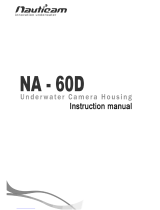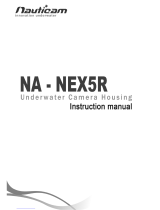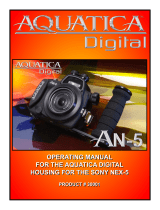Page is loading ...

Product Registration
Please register your product within 15 days of purchase. Our product
registration database is the quickest way for us to contact you in the
event of a product update.
To register, send a photo of the above registration label to us via
[email protected] along with your name, address, and phone
number.
200DLM/A Underwater Housing for Canon EOS
M10
Product # 6973.10

2
Introduction
Thank you for your purchase of Ikelite products.
Our primary focus is to provide quality, professional grade products
for use in and under water. Our products are designed, manufactured,
and distributed from our sole facility in Indianapolis, USA where we
started in 1962.
We are available if you have any questions or want photo advice.
Send us an email 24 hours a day to [email protected]. We strive to
reply within 1 business day.
An electronic version of this instruction manual is available for
download via the product page on our website:
https://www.ikelite.com
In the Box
• Housing
• Rear o-ring # 0110 (installed)
• Front o-ring # 0132.36 (installed)
• .050” hex key # 0945.11
• 1/16” hex key # 0945.16
• Silicone lubricant 1cc tube

3
Important Notices
» This housing requires a compatible DLM lens port for
waterproof operation. The housing is not waterproof without a
DLM lens port attached.
» A bulkhead cap or sync cord must be attached to the housing
bulkhead for waterproof operation. Never submerge the
housing in water without either a sync cord or bulkhead cap
attached.
» Do not pull the shutter trigger without a camera installed. You
may accidentally detach or damage the control spring.
» Never leave a housing in a rinse tank, even if it is the only
system in the tank. Accidental damage may occur when the
user walks away from a housing while it is in the rinse tank.
» Do not use alcohol, cleaning agents, spray lubricants, Rain-X,
or other solvents on the housing or lens port. Use of an
incompatible chemical compound can damage the plastic and
o-rings, and may result in leaking.
» If you will be using the system in strong surf it is
recommended to draw a vacuum on the housing using the
optional vacuum kit (sold separately).

4
Contents
Product Registration 1
Introduction 2
In the Box 2
Important Notices 3
Getting to Know Your Housing 6
Tray Mounts 8
Setting Up Your Camera 8
Pre-Installation Checklist 8
Camera Settings 8
Exposure Settings 8
Setting Up Your Housing 9
Opening the Housing 9
Installing the Camera 9
Closing the Housing 10
Attaching a Lens Port 11
Installing the Lens and Port 11
Setting Up An External Strobe 14
About Fiber Optic Cords 14
Attaching a Fiber Optic Cord 15
Getting in the Water 15
Final Check 15
Entering the Water 16
Shooting Underwater 16
Learning about Underwater Photography 17
Maintaining Your Housing 17
Post-Dive 17
Lens Port 18
Storage 18
Servicing Recommendations 19

5
Lubricating Controls 19
Lubricating Push Buttons 20
Lubricating Control Shafts 21
Troubleshooting 22
Spare Parts 24
Limited Warranty 25
Service and Repairs 25
Contact Us 26

6
Getting to Know Your Housing
Shutter
Fiber optic
ports
Lid snap
Tray mounts
Lens
release
Port mount
Flash
switch
Movie
Front dial
Power

7
INFO
MENU
Viewnder
Rear o-ring
INFO
MENU
Left
Playback
Lid
snap
hook
Up / Erase
Down / Info
Right / Flash
INFO
Flash
OK
Command
dial
Menu

8
Tray Mounts
This housing features two 1/4-20 threaded tray mounts on the bottom
of the housing. The spacing between the tray mounts is 3” (76.2 mm).
Optional tray with handles and mounting hardware are sold separately.
It is recommended to detach and thoroughly rinse the tray mounts,
tray, and mounting hardware, with fresh water routinely during
continuous use and prior to storage.
Setting Up Your Camera
Pre-Installation Checklist
1. Insert a fully charged camera battery.
2. Insert a properly formatted memory card.
3. Remove any attached lanyard or neck strap.
Camera Settings
• Set Flash ring to “On” when using an external strobe.
• Set AF assist beam to “Off” when using an external strobe.
• Set Red-eye reduc. to “Off” when using an external strobe.
Exposure Settings
Refer to the Cheat Sheets in the Photo School section of our website
for recommendations on exposure settings for a wide variety of
shooting situations:
https://www.ikelite.com/blogs/cheat-sheets

9
Setting Up Your Housing
Opening the Housing
1. Push the lid snap lock forward and lift the curved end away from
the housing.
Lock
2. Lid snaps are designed to provide enough force to compress the
o-ring for a proper seal. Keep rm pressure against the lid snap
while lifting it away.
3. Repeat with opposite lid snap.
4. Remove the housing back.
Installing the Camera
1. Remove any lanyard or neck strap which may be attached to the
camera.
2. Remove the camera mount plate from the housing.

10
3. Line the mount screw up with the camera’s tripod socket. Use a at
screwdriver to tighten the mount plate to the camera.
LENS
Mount screw
1/4-20 tripod
mount
Camera
tripod socket
4. Pull out on the housing control knobs to move the controls out of
the way.
5. Insert the mount plate into the slot on the inside bottom of the
housing. Push the camera all of the way forward until it stops.
6. Push housing control knobs in and check orientation with the
camera.
» The camera may be attached to a tripod using the 1/4-20
threaded mounting hole on the bottom of the mount plate.
Closing the Housing
1. Make sure the o-ring is clean and in its proper location on the back
of the housing. The rear housing o-ring does not require lubricant
to make a seal.
2. Place the back onto the housing front.
3. Make sure no controls or wires are interfering with the o-ring or the
back of the housing.

11
4. Place each lid snap into the corresponding hook on the housing
back.
5. Push the lid snaps towards the housing until they are at against
the housing and the lock has engaged. Close both lid snaps at the
same time.
6. Check the o-ring seal. The o-ring should form a uniform, solid line
visible through the back of the housing.
7. Check control functions.
Attaching a Lens Port
Refer to the DLM/C lens port chart to nd compatible lens ports for a
wide variety of popular wide angle, zoom, and macro lenses.
Choose a dome port for wide angle and zoom lenses. Larger diameter
domes are better for split shots (half-in, half-out of the water) and
provide sharper images.
Choose a at port for macro lenses. Flat ports magnify the subject
underwater. Flat ports are not recommended for wide angle or zoom
lenses due to their limited eld of view and risk of vignetting (dark
shadows around the edges of the image).
» This housing requires a compatible DLM lens port for
waterproof operation. The housing is not waterproof without a
DLM lens port attached.
Installing the Lens and Port
1. If using a zoom gear, refer to the zoom gear instructions for proper
assembly procedure. Attach the lens to the camera.
2. Check that the port sealing surface and o-ring are clean and free
of debris.

12
3. Apply a very thin, even layer of lubricant to the exposed portion of
the front o-ring and to the lens port sealing surface. Avoid dry spots
or uneven build-up of lubricant.
4. Loosen the port thumbscrews until they do not show on the inside
of the lens port.
5. If using a port with a dome shade, align the port so that the tall
projections on the dome shade are in the 12 and 6 o’clock
positions.
Shade
Thumbscrew
O-ring
Thumbscrew
groove
Zoom gear

13
6. Press the port rmly towards the housing until the base of the port
is almost ush with the housing front. If there is resistance, remove
the port and re-check that the thumbscrews are loosened and the
o-ring is properly lubricated.
7. Tighten all three thumbscrews while holding the port rmly towards
the housing. The thumbscrews should thread in completely until
the head touches the port. If the screws are difcult to turn and/or
they bottom out before their heads are ush, it is an indication that
the port is not pushed far enough down on the housing.
Small gap
~ 0.15” (4mm)

14
» The port must be fully seated onto the housing for waterproof
operation. There should only be a very thin, even gap of
approximately 0.15” (4mm) between the bottom of the port and
the front of the housing.
Setting Up An External Strobe
We recommend attaching an external strobe for the optimal color and
clarity in a wide variety of photographic situations, including daylight
photography.
This housing provides ber optic ports for optical triggering of up to
two strobes.
About Fiber Optic Cords
Connecting a strobe via ber optic cord requires the camera’s built-in
ash to re for every photo. Rapid ring will be limited to the recycle
time of the camera’s built-in ash or the recycle time of the strobe,
whichever is slower.
The following ber optic cords are compatible with this housing:
• Ikelite Fiber Optic Cord # 4501
• INON Optical D Cable “Non-wireless type” L-Connector
• SEA&SEA Fiber Optic Cable (L-type) # 50107
• SEA&SEA Fiber Optic Cable II # 50128
• Olympus UW Fiber Optic Cable # PTCB-E02
• Nauticam Optical Fiber Cable # 26211 Nauticam to INON
• Nauticam Optical Fiber Cable # 26212 Nauticam to SEA&SEA
» To connect two strobes to the housing, you must use two ber
optic cords.

15
Attaching a Fiber Optic Cord
1. Check the end of the ber optic cord to ensure that it is clean and
smooth.
2. Check that the ber optic cord o-ring is in place. This o-ring does
not provide waterproong, but it does keep the ber optic cord in
place.
3. Attach one end of the ber optic cord to one of the ber optic ports
on the housing. The connector is a press-t into the port.
4. Attach the other end of the ber optic cord to a compatible strobe.
5. Set the strobe according to the manufacturer recommendations.
6. Turn on the strobe.
7. Turn on the camera. Take a test photo to ensure that your strobe(s)
are functioning properly.
Getting in the Water
Final Check
1. Re-check the rear o-ring seal. The seal should form an even, solid
line visible through the back of the housing.
2. Turn on the camera and check all control functions.
3. Make sure the camera can take a photo.
4. Check camera battery level and available storage space on your
memory card.

16
5. Submerge the housing in a fresh water tank dedicated to
underwater photography equipment. Visually conrm that there are
no signs of water intrusion. One sign of water intrusion is a steady
stream of bubbles coming from one of the housing’s seals.
Entering the Water
1. Before entering the water, turn the camera on and operate each
of the housing controls to get a feel for using the camera in the
housing.
2. We recommend entering the water without your housing to ensure
you are comfortable and your life-saving equipment is in working
order. Once you are stable, have someone pass your camera
housing to you.
3. Submerge the housing at the surface of the water and visually
conrm that there are no signs of water intrusion. Look for water
droplets or fogging inside of the housing, or a steady stream of
bubbles coming from one of the housing seals.
4. Use your hand to gently ush away any small bubbles that may be
on the face of the lens port. Bubbles will produce soft focus spots
in your photo or video.
» If water appears to be entering the housing, point the lens port
downward and return the housing to the surface immediately.
Please observe all necessary safety precautions. NEVER
ascend faster than accepted safety limits.
Shooting Underwater
• Get as close as possible to your subject. For the best results, only
photograph subjects that are less than 6’ (1.8m) away.
• Be careful not to stir up sand or silt.
• Photograph subjects straight on or at a slight upward angle.

17
• If you err in exposure, it is better to have the image slightly
underexposed rather than overexposed. An overexposed image
is missing color information which cannot be adjusted in a photo
processing program. A slightly underexposed image has color
information that can be adjusted.
» It is important to respect all living creatures underwater,
including people, marine life, and coral. Get as close as you
can to your subjects when taking a photograph, but never
touch or disturb the marine life.
Learning about Underwater Photography
Visit the Photo School section of ikelite.com for a wide range of
information on shooting underwater including:
• Product Tutorials and Videos
• Cheat Sheets with exposure setting recommendations for a wide
variety of situations
• Advanced Techniques with in-depth articles on different shooting
techniques
• Frequently Asked Questions
• Photo Galleries showing examples of real results underwater
• Feature Articles and more!
Maintaining Your Housing
Post-Dive
1. Rinse the housing in fresh water. Rotate the housing controls and
press each button several times while submerged in fresh water to
ush out any salt or debris to ensure smooth operation on future
dives.

18
2. NEVER leave your housing in a fresh water rinse tank, even if it is
the only system in the tank. Collisions with another person’s gear
can cause scratches or damage to your equipment. Accidental
damage occurs most often in the rinse tank.
3. Rinse off any residual residue from the rinse tank with clean,
running fresh water.
4. Stow the housing in a shaded place where it is protected from
impact and overheating. If no shade is available, cover the housing
with a light colored towel or cloth.
5. Check the memory card capacity and battery life of your camera
and strobe(s). Recharge as necessary.
6. Always re-check the o-ring seal after opening the housing.
» Do not rinse the inside of the housing. The viewnder and
hotshoe are susceptible to water damage.
Lens Port
Treat the surface of the lens port like a camera lens. After use, rinse
and gently dry the outside lens port to avoid water spotting. Use only a
microber lens cleaning cloth to avoid scratches. To clean, use a mild
soap solution.
» Do not rinse the inside of the lens port.
» Do not use alcohol, cleaning agents, spray lubricants, Rain-X,
or other solvents on the housing or lens port. Use of an
incompatible chemical compound can damage the plastic and
o-rings, and may result in leaking.
Storage
1. Clean the housing and controls thoroughly prior to storage.
2. Remove the rear o-ring. Place in a small re-sealable plastic bag
inside of the housing.

19
3. Leave the lid snaps open to release pressure on the lid snap
springs.
4. Store the housing in a cool, dry place away from direct sunlight
and chemicals.
5. Before using the housing, check the tightness of the set screw in
each control knob. Check each control gland to make sure they are
snug. There is a slight chance that either could vibrate loose during
travel.
» Do not leave the camera and housing in direct sunlight for
prolonged periods. Heat may damage the camera.
» Do not transport with the camera inside of the housing.
» Do not store the housing in a humid environment. Prolonged
exposure to high humidity may damage electronic
components.
Servicing Recommendations
It is recommended that the housing be sent to Ikelite or an authorized
service center annually for routine service and maintenance. Service
may be required more or less frequently depending on care and use.
Lubricating Controls
The housing’s controls may need to be lubricated if they become
particularly difcult to use or if the o-rings have dried out during longer
periods of storage.
There will be some breaking force required to move the controls
initially after the housing has been in storage for long periods of time.
Remove controls for lubrication only if they continue to stick after
applying a small amount of lubricant to the exposed portion of the
shafts and working them many times.

20
» Use only Ikelite lubricant. Other types of lubricant may cause
swelling of o-rings or cracking of plastic components.
» Lubricant is not a sealant; it is used to reduce friction.
Excessive lubricant can collect sand, hair or debris which may
interfere with proper sealing.
» Never use spray lubricants as the propellant ingredient can
cause the plastic housing to crack or o-rings to swell.
Lubricating Push Buttons
1. Press and hold the push button all the way in.
2. Place a small amount of lubricant at the base of the push button
shaft inside the housing.
3. Press and release the push button several times to work the
lubricant into the o-ring.
4. If a push button control becomes difcult to push or if it sticks when
depressed, soak the housing in warm, soapy fresh water. After a
few minutes, operate the push button. If this does not correct the
problem, return the housing to Ikelite for maintenance.
» To prevent build-up of salt, sand, or debris, the push buttons
should be ushed with fresh, clean water after every use.
Depress each push button while the housing is submerged in
fresh water.
/








